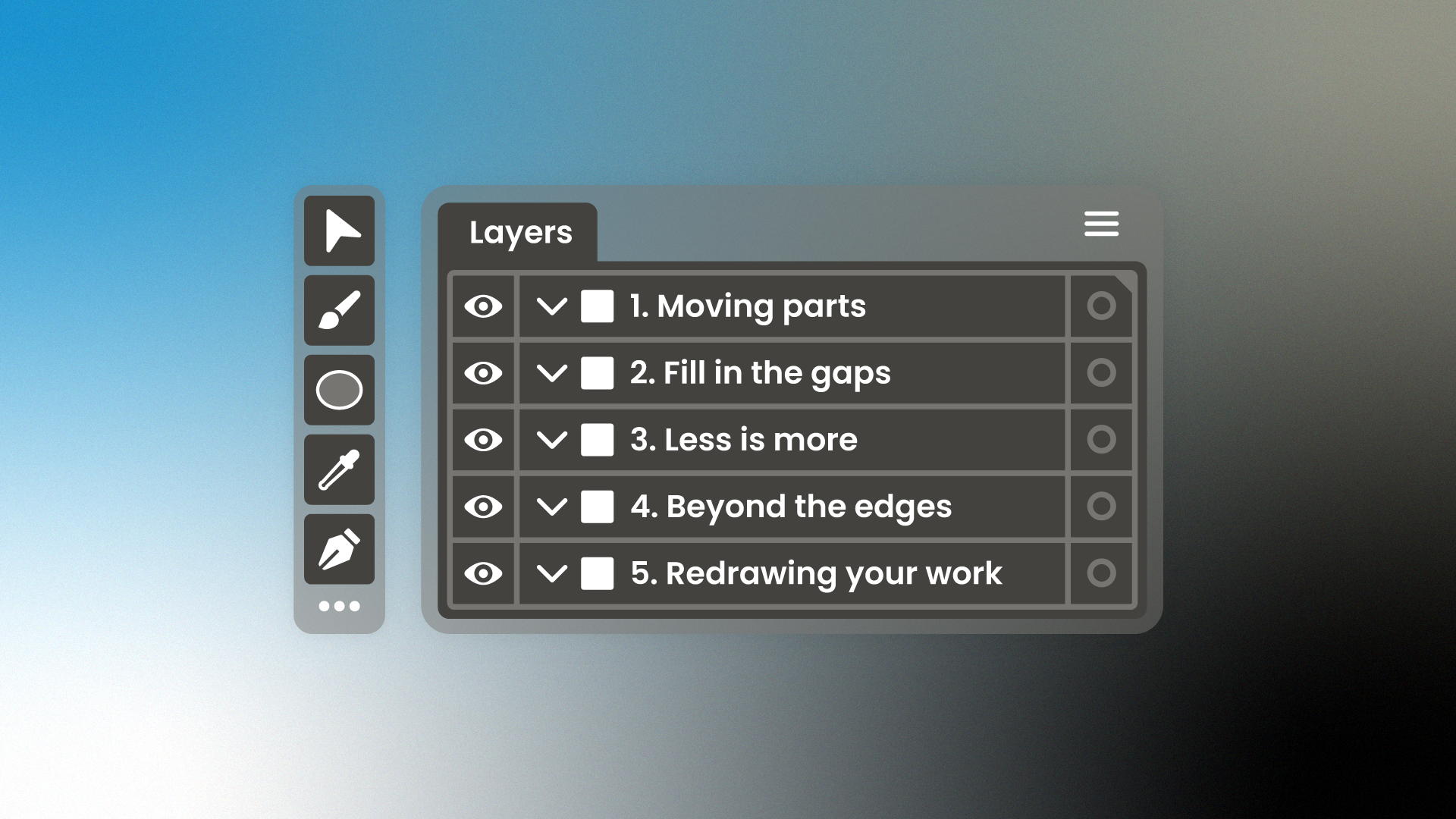How to prepare illustration files for animation
Moving images and animations are increasingly in demand from clients because they hold the viewer’s attention longer than static illustrations. If you haven’t yet been asked to make your artwork move, no doubt you will be soon. As screens become ubiquitous, everything is coming alive with motion to catch the eye and add a little spark of magic.

For your illustration to make the transition to video or GIF, you may well be asked to work with a specialist animator. For that collaboration to go smoothly, the animator will require you to deliver your artwork files in specific ways. Here we’ve listed five things to consider when preparing your work for animation:
1. Moving Parts
Anything that could move independently should be on a separate layer. We’re talking foreground, midground, vehicles, trees, leaves, bodies, arms, fingers, fingernails – well, maybe not fingernails, but you get the idea: split up those drawings!
Example: An image of a person at an outdoor cafe table should be broken into separate layers not only for each of the character’s body parts but also the chair, the elements on the table and any incidental details that might pass through the scene, such as a fluttering butterfly or a bird hoping for crumbs, which give the scene life.
2. Fill in the Gaps
Illustrating for print produces a static image with a single point of perspective: where elements overlap, only the foreground object is fully drawn. When Illustrating for animation, however, the areas behind foreground elements also need to be completed. Any elements that do not have completed layers behind them cannot be put in motion without some redrawing of the background.
Example: If an animal is in the foreground, complete the background layer including the section behind the animal so that the critter can move. If two plants overlap, complete both so that they can independently sway in the breeze.
3. Less is More
Try to keep complex details to a minimum. Certain styles are more detailed than others, of course, and animation shouldn’t be a restriction for your creativity. As a general rule of thumb, however, the longer it takes to draw, the longer it takes to animate. Teamwork makes the dreamwork, y’all!
Example: If there are a lot of hand-drawn hairs and the style requires frame-by-frame animation, each hair will need to be redrawn for every frame. That’s fine for Hollywood blockbusters where whole teams might be dedicated to animating only hair, but your project may not be blessed with quite the same budget…
4. Beyond the Edges
Draw all objects in full, even if they are cropped off your artboard. This allows the animator the freedom to move the object in and out of shot. Similarly, extending your backgrounds much wider than the frame gives the animator the flexibility to pan the camera or add engaging parallax effects.
Example: If the rear of the car is out of frame, draw the whole car so the animator is able to move it. And the road it is on? Extend that off the edges of your initial scene so that the roadster has somewhere to go.
5. Redrawing your Work
No matter how well you have prepared your file, sometimes your work will need redrawing during animation. Be ready to redraw some elements if requested, or be willing to cede some artistic license to the animator. Depending on the shot, animators may use your artwork only as a reference, but the animator’s goal is always for the moving image to feel just like your original artwork, though their additions will never be a 100% match because only you can make your style perfectly – that’s why it’s yours!
Example: Complex movements around objects may need to be roughly drawn frame-by-frame and then individual elements redrawn using your illustrations as a reference. Furthermore, if camera angles rotate around elements, your 2D illustrations may even need to be recreated in 3D.
Prepare to be moved
If you’re still sure what needs prepping, ask the animator – don’t be afraid, there are no silly questions! The animator will tell you what they plan for the scene, how things might move, and whether they will need any extra assets from you. Exploratory conversations at the start will lead to more satisfying results because the animator will better understand your illustration process and you can work towards a closer style match for the final animation.
It is not a bad idea to develop a general working process that enables animation, even for jobs that do not require movement. This lays a good foundation for when those animation jobs appear, and it is not unusual for a client to request that an existing illustration be lightly animated – having a layered artwork makes that process so much easier.
The Folio Lab animators work with all kinds of illustration styles – some are more straightforward to animate than others – but if the illustrator prepares their files with animation in mind then the collaboration will run smoothly and result in a stunning artwork with a life of its own.
